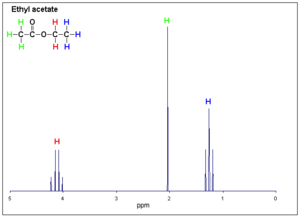Difference between revisions of "NMR spectrometer"
Cmditradmin (talk | contribs) m |
|||
| (23 intermediate revisions by one other user not shown) | |||
| Line 1: | Line 1: | ||
<table id="toc" style="width: 100%"> | |||
<tr> | |||
<td style="text-align: center; width: 33%">[[Main_Page#Research Equipment, Devices and Techniques|Return to Research Tool Menu]]</td> | |||
</table> | |||
=== Background === | |||
[[Image:F3bb1f30c7.jpg|thumb|300px| ]] | |||
Nuclear magnetic resonance NMR spectroscopy is a sensitive chemical analytical technique which detects the magnetic properties of certain atoms such as hydrogen and carbon. The resulting spectrum can be compared against a database of known NMR signatures to identify atoms or functional groups in sample mixture. A typical application is to use NMR to prove that a sample pure or has completed a reaction. | Nuclear magnetic resonance NMR spectroscopy is a sensitive chemical analytical technique which detects the magnetic properties of certain atoms such as hydrogen and carbon. The resulting spectrum can be compared against a database of known NMR signatures to identify atoms or functional groups in sample mixture. A typical application is to use NMR to prove that a sample pure or has completed a reaction. | ||
The following animation shows a single proton as it aligns to a strong magnetic field and then flips or precesses in an RF field. When the input RF is stopped the proton relaxes over a period of seconds and releases its energy in the form of an RF signal which is then recorded. The raw RF signal records the energy released by millions of protons located in different molecular environments. Fourier transform reduces the signal consisting of many resonant wavelengths down to distinct frequency spikes representing protons in different functional groups. | |||
<swf width="500" height="400">images/b/be/Nmr.swf</swf> | |||
=== Significance === | |||
Protons create different resonance spikes depending where they are located on the molecule. Non identical protons will exhibit individual peaks. But equivalent protons will couple to create a single stronger peak. | |||
[[Image:1H NMR Ethanol Coupling shown.GIF|thumb|left|300px| Calculated NMR showing coupling for ethanol ]] | |||
[[Image:1H NMR Ethyl Acetate Coupling shown.GIF|thumb|300px| Calculated NMR showing coupling for ethyl acetate]] | |||
<br clear='all'> | |||
=== Operation=== | |||
Bruker Icon NMR with Tanya David. | |||
{{#ev:youtube|BirHLLz3aXc}} | |||
This provides instructions for a Bruker Advance 300 NMR. | |||
Below is YouTube video from RSC | |||
{{#ev:youtube|uNM801B9Y84}} | |||
=== External Links === | === External Links === | ||
*[[wikipedia:NMR_spectroscopy]] | *[[wikipedia:NMR_spectroscopy]] | ||
*[http://en.citizendium.org/wiki/NMR_spectroscopy] | *[http://riodb01.ibase.aist.go.jp/sdbs/cgi-bin/direct_frame_top.cgi Spectral database including HNMR] | ||
*[http://www2.chemistry.msu.edu/faculty/reusch/VirtTxtJml/Spectrpy/nmr/nmr1.htm#nmr1 NMR primer William Reusch MSU] | |||
*[http://www2.chemistry.msu.edu/faculty/reusch/VirtTxtJml/Spectrpy/nmr/nmr2.htm NMR primer part 2] | |||
*[http://en.citizendium.org/wiki/NMR_spectroscopy citizendium NMR article] | |||
*[http://www.chem.queensu.ca/FACILITIES/NMR/nmr/webcourse/list.htm NMR animations from Queens University] | |||
*[http://www.cis.rit.edu/htbooks/nmr/ Hornaks Basics of NMR ] | |||
*[http://vam.anest.ufl.edu/forensic/nmr.html NMR basics animation from U of Florida] | |||
Latest revision as of 13:35, 24 January 2011
| Return to Research Tool Menu |
Background
Nuclear magnetic resonance NMR spectroscopy is a sensitive chemical analytical technique which detects the magnetic properties of certain atoms such as hydrogen and carbon. The resulting spectrum can be compared against a database of known NMR signatures to identify atoms or functional groups in sample mixture. A typical application is to use NMR to prove that a sample pure or has completed a reaction.
The following animation shows a single proton as it aligns to a strong magnetic field and then flips or precesses in an RF field. When the input RF is stopped the proton relaxes over a period of seconds and releases its energy in the form of an RF signal which is then recorded. The raw RF signal records the energy released by millions of protons located in different molecular environments. Fourier transform reduces the signal consisting of many resonant wavelengths down to distinct frequency spikes representing protons in different functional groups.
<swf width="500" height="400">images/b/be/Nmr.swf</swf>
Significance
Protons create different resonance spikes depending where they are located on the molecule. Non identical protons will exhibit individual peaks. But equivalent protons will couple to create a single stronger peak.
Operation
Bruker Icon NMR with Tanya David.
This provides instructions for a Bruker Advance 300 NMR.
Below is YouTube video from RSC

